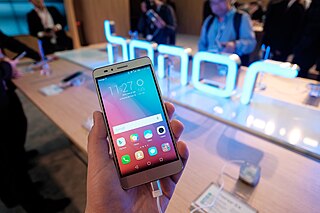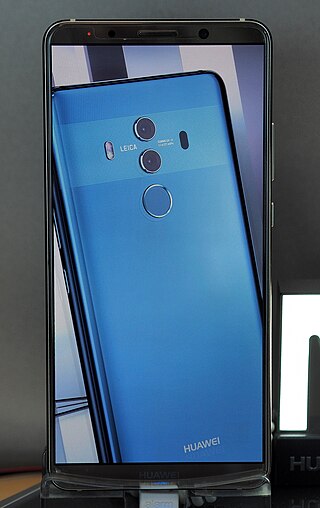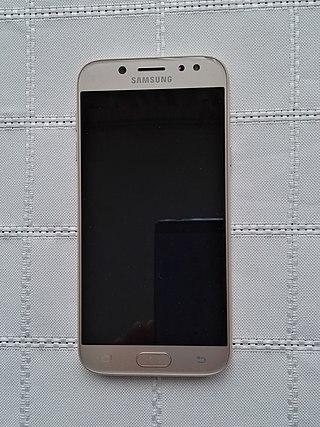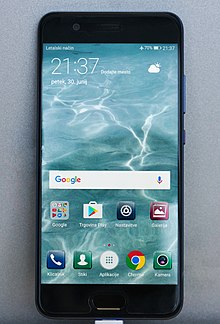
The Acer Iconia is a range of tablet computers from Acer Inc. of Taiwan.

Nexus 6P is an Android smartphone developed and marketed by Google and manufactured by Huawei. It succeeded the Nexus 6 as the flagship device of the Nexus line of Android devices by Google. Officially unveiled on 29 September 2015 along with the Nexus 5X at the Google Nexus 2015 press event held in San Francisco, it was made available for pre-order on the same day in United States, United Kingdom, Ireland, and Japan.
The HTC One M9+ is an Android smartphone manufactured and marketed by HTC which was announced on April 8, 2015. Initially on launch, the device was only sold in China. In July 2015, the device was released in Europe excluding the United Kingdom.

The Huawei Honor 5X is a mid-range Android smartphone manufactured by Huawei as part of the Huawei Honor X series. It uses the Qualcomm Snapdragon 616 processor and an aluminum body design. It was first released in China in October 2015, and was released in the United States and India in January 2016.

The Honor 8 is a smartphone made by Huawei under their Honor sub-brand. It is a successor of the Huawei Honor 7 within the Huawei Honor series.
The Huawei Mate 9 is a high-end Android smartphone, designed and produced by Huawei as part of the Huawei Mate series. It was released on 3 November 2016. It was succeeded by the Huawei Mate 10 series, and later the Huawei Mate 20 series.

The Huawei G8 is an upper mid-range Android smartphone designed and produced by the company Huawei. It was released on 2 September 2015.

The Samsung Galaxy J7 Prime is an Android-based smartphone unveiled, produced, released and marketed by Samsung Electronics. It was unveiled in August 2016 and released the month after. It was the first J series smartphone to feature an aluminium metal chassis alongside the Galaxy J5 Prime.The new smartphone included several new features that had never been used before on a phone for example the phone featured split screen application modes

Moto G5 is a series of Android smartphones developed by Motorola Mobility, a subsidiary of Lenovo. It is the fifth generation of the Moto G family. Announced as successors to the Moto G4, they were first released in March 2017 in several markets including India and Europe. The original variants are the Moto G5 and Moto G5 Plus, the latter also being available as an Amazon Prime version in the United States. The mid-cycle updates, the Moto G5s and Moto G5s Plus, were released in August 2017.

The Sony Xperia XZ1 is an Android smartphone manufactured and marketed by Sony. Part of the Xperia X series, the device was announced to the public along with the Xperia XZ1 Compact at the annual IFA 2017 on August 31, 2017. It is the direct successor to the Sony Xperia XZ according to Sony, and is the latest flagship after the Xperia XZ Premium.

The Huawei Mate 10, Huawei Mate 10 Pro and Huawei Mate 10 Lite are Android smartphones designed and marketed by Huawei as part of the Huawei Mate series. There is also a Mate 10 Porsche design, which has 256Gb of storage but is otherwise identical to the Mate 10 Pro. They were first released on 16 October 2017. Versus the predecessor Mate 9, the Mate 10 pro flagship phone has a faster processor with an integrated neural processing unit, a slightly larger OLED screen (6.0") with a taller 18:9 aspect ratio, a significantly longer battery life and a glass back construction. Chinese and international models are available in dual SIM configuration. It comes with Android 8 and a newer version of Huawei's EMUI interface. All Mate 10 models are unlocked and GSM only. Huawei phones, including the Mate series, are not sold or financed through U.S. carriers due to pressure from U.S. intelligence agencies, though they are available from independent and online retailers.
Xiaomi Redmi 5 and Xiaomi Redmi 5 Plus are smartphones developed by Xiaomi Inc, announced on 7 December 2017. They are part of Xiaomi's budget Redmi smartphone line. The Redmi 5 Plus has been rebranded as Redmi Note 5 for the Indian market.

Samsung Galaxy J5 2017 is an Android-based smartphone produced, released and marketed by Samsung Electronics. It was unveiled and released in July 2017 along with the Samsung Galaxy J3 (2017). It has an advanced 64-bit class system on a chip (SoC) backed by 2 GB or 3 GB Of LPDDR3 RAM. It packs a Non-removable 3000 mAh battery. The Galaxy J5 (2017) is the successor to the Samsung Galaxy J5 (2016).

Huawei P20 and Huawei P20 Pro are Android smartphones manufactured by Huawei. Unveiled 27 March 2018, they succeed the Huawei P10 in the company's P series line.
Oppo phones are smartphones produced by the partially state-owned Chinese company Oppo, running in several countries.

Huawei Mate 20 is a line of Android phablets produced by Huawei, which collectively succeed the Mate 10 as part of the Huawei Mate series. The flagship models, the Mate 20 and Mate 20 Pro, were unveiled on 20 July 2018 at a press conference in London.

Huawei P30 is a line of Android-based smartphones manufactured by Huawei. Unveiled on 26 March 2019, they succeed the Huawei P20 in the company's P series line.

The Honor 8x is a smartphone made by Huawei under their Honor sub-brand. It is a successor of the Huawei Honor 7x within the Huawei Honor series.

Huawei Mate 30 is a line of Android-based phablets manufactured by Huawei as part of its Huawei Mate series, and the successor to the Mate 20. The Mate 30 comprises the Mate 30/5G, Mate 30 Pro/5G, and Mate 30 RS Porsche Design, which were unveiled on 19 September 2019 in Munich, Germany.
The Huawei Nova 7 is an Android smartphone manufactured by Huawei. It spots a 6.53-inch display with a 20:9 aspect ratio.














